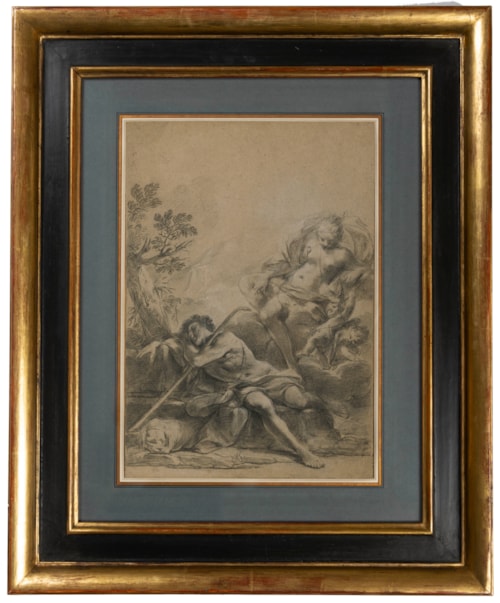Francesco MONTI
(Bologna 1685 - Brescia 1768)
Diana and Endymion
Black chalk, with stumping, on light brown paper, with framing lines in brown ink and laid down on an 18th century English mount.
Inscribed N425 / ex coll RG / HCH U. / del Sole / Diana & endimion. on the reverse of the mount.
398 x 277 mm. (15 5/8 x 10 7/8 in.)
Inscribed N425 / ex coll RG / HCH U. / del Sole / Diana & endimion. on the reverse of the mount.
398 x 277 mm. (15 5/8 x 10 7/8 in.)
Formerly attributed to Francesco Monti’s teacher Giovanni Gioseffo dal Sole, this evocative night scene depicts the Roman goddess of the moon, Diana (also known as Selene in Greek mythology), who fell in love with the beautiful young shepherd Endymion, and would visit him every night while he slept on the mountaintop where he guarded his sheep. In the present composition the goddess is accompanied by Cupid, who aims his arrow at Endymion’s heart.
The inscription on the reverse of the 18th century mount of this drawing states that the work was formerly in the ‘R.G.’ collection. While nothing is known of this collection, a similar inscription is found on a related drawing of An Allegory of Autumn by Francesco Monti, of similar technique and dimensions, in the Fitzwilliam Museum in Cambridge. The Fitzwilliam drawing was also once in the ‘R.G.’ collection and was likewise previously attributed to Dal Sole4. The same ‘R.’ or ‘R.G.’ collection included at least two further drawings by Monti, each depicting the Roman goddess Ceres with attendant putti; both drawings appeared, with attributions to Dal Sole, at auctions in London in 1981.
All of these drawings, including the present sheet, may further be grouped with a series of large-scale compositional drawings of allegorical or mythological subjects by Monti, all of which are similar in medium and style, in the collections of the Accademia Carrara in Bergamo and the Royal Collection at Windsor Castle. The latter houses nine drawings by Monti of this type, including another depiction of the subject of Diana and Endymion, different in composition to the present sheet. All of these drawings may be dated to relatively early in Monti’s career, when he was closely associated with the Accademia Clementina in Bologna, and before his departure for Brescia in 1736. In his 1968 monograph on Monti, the scholar Ugo Ruggeri tentatively suggested that these drawings may have been modelli for the decoration of a palace, but it is equally likely that such large and highly finished drawings as the present sheet may have been produced as works of art in their own right, and intended for sale to collectors.
Later in his career, Monti is known to have painted a ceiling fresco of the subject of Diana and Endymion for the Casa Barussi in Brescia, which is now lost. Ruggeri has related three drawings to this project, all of which show the figures of the goddess and the shepherd in a different arrangement than seen in the present sheet. One of these is the Diana and Endymion at Windsor, which is the only one of the nine related drawings by Monti in that collection that is of oval format and is squared for transfer.
Following a period of study in Modena with Sigismondo Caula, Francesco Monti returned in 1693 to his native Bologna, where he completed his training in the studio of Giovan Gioseffo Dal Sole. The Venetian qualities inherited from Caula remained evident in his work throughout his long and successful career. Among his important early works is the large Pentecost for the church of San Prospero in Reggio Emilia, dated 1713. His career flourished in the 1720’s, when he received a number of significant commissions for history paintings and was elected to a term as principe of the Accademia Clementina.
Together with such artists as Donato Creti, Sebastiano and Marco Ricci, Giambattista Pittoni, Canaletto, Giovanni Battista Piazzetta and others, Monti contributed to a series of large allegorical paintings of imaginary tombs commemorating prominent British noblemen, commissioned by the Irish entrepeneur Owen McSwiny in the late 1720’s and 1730’s from teams of the foremost Venetian and Bolognese painters of the day. Monti also executed several paintings for churches in Bologna and the surrounding region, among them a Death of Saint Peter Martyr for San Domenico in Modena, completed in 1732. Four years later he moved to Brescia to work on the decorations, now lost, of the Palazzo Martinengo. The success of this project led to further commissions, and Monti eventually established a flourishing practice in Brescia. The later years of his career were spent working mainly in Lombardy – mainly in Brescia, Cremona and Bergamo – on a number of large-scale fresco commissions. Among his most significant late works is the extensive decoration of the church of Santa Maria della Pace in Brescia.
Monti is perhaps better known today as a draughtsman than as a painter. As has been noted of the artist, ‘Monti’s drawing style is highly individualistic: it is based on the firm Bolognese academic tradition, but the treatment of the chalk medium, which he preferred, is handled with a particular deftness...His lightness of touch, combined with the “Neo-Mannerist” predilection for attenuated figures, produce a combination of elegance and spontaneity rare in the Bolognese tradition.’ Monti was a prolific and gifted draughtsman, producing both figure studies in black chalk and compositional drawings in red chalk.
Provenance
‘R.G.’ collection (according to the inscription on the reverse of the mount)
Private collection, London.
Private collection, London.











